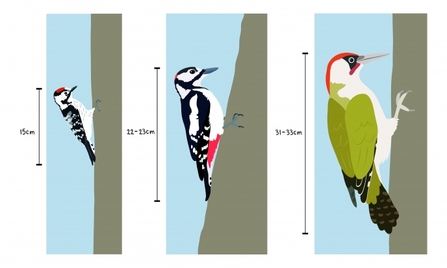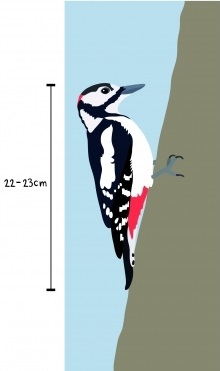What woodpecker have I seen?
There are three species of British woodpecker - here's how to tell them apart.

Illustration by Corinne Welch

Illustration by Corinne Welch
Green woodpecker
With its brightly coloured feathers, the green woodpecker looks a bit like a big parrot. It’s our largest species, but hardly ever drums. Instead, green woodpeckers communicate with a loud call that sounds like a crazy laugh and is known as a ‘yaffle’. The green woodpecker is olive-green, with a yellow rump, red crown and black around the face. Males have a red 'moustache' edged by black, but females have an all-black moustache.

Illustration by Corinne Welch
Great spotted woodpecker
The great spotted woodpecker is black and white, with white shoulder patches and red underneath the tail. Males have a red patch at the back of the head. Only likely to be confused with the lesser spotted woodpecker which is much smaller. Great spots are our most common woodpeckers and the best drummers by a long way. They beat their beaks against hollow branches or tree trunks at a stunning 40 hits per second.

Illustration by Corinne Welch
Lesser spotted woodpecker
This is Britain’s smallest woodpecker by far – it’s barely bigger than a sparrow! Males are black and white, with a red crown cap, and females are plain black and white. They both have a distinctive white ladder marking down their black back. It’s our rarest as well and only lives in England and Wales. Listen out for their drum solos in spring – they may be quieter than the great spot’s, but they last longer.
Can you help?
There are now believed to be less than 3,000 pairs of lesser spotted woodpeckers breeding annually in the UK compared to nearly 45,000 greater spotted woodpeckers. The Wildlife Trusts manage many woodland nature reserves for the benefit of the wildlife they support. You can help by supporting your local Trust and becoming a member; you'll find out about exciting wildlife news, events on your doorstep and volunteering opportunities, and will be helping local wildlife like woodpeckers along the way.






